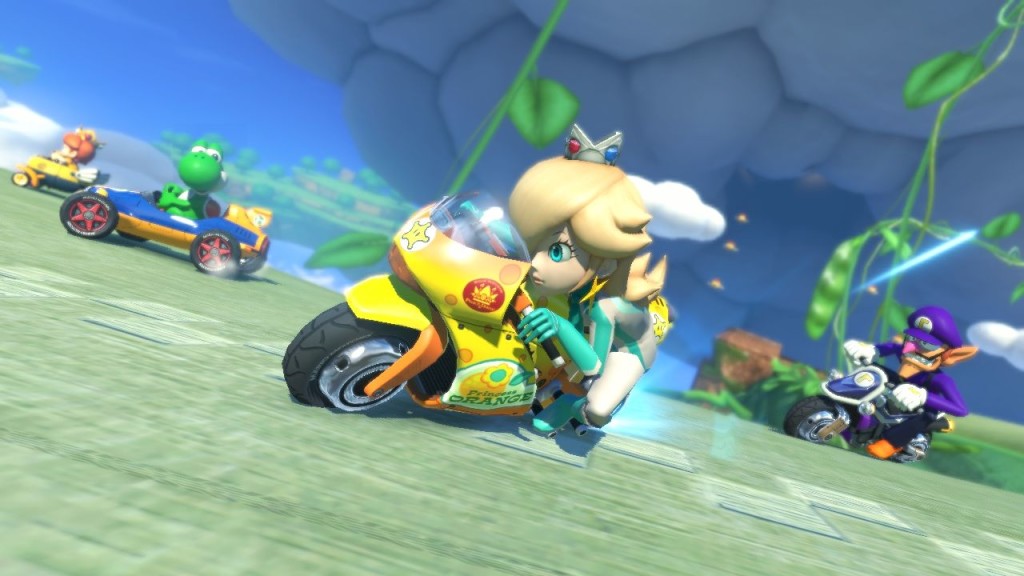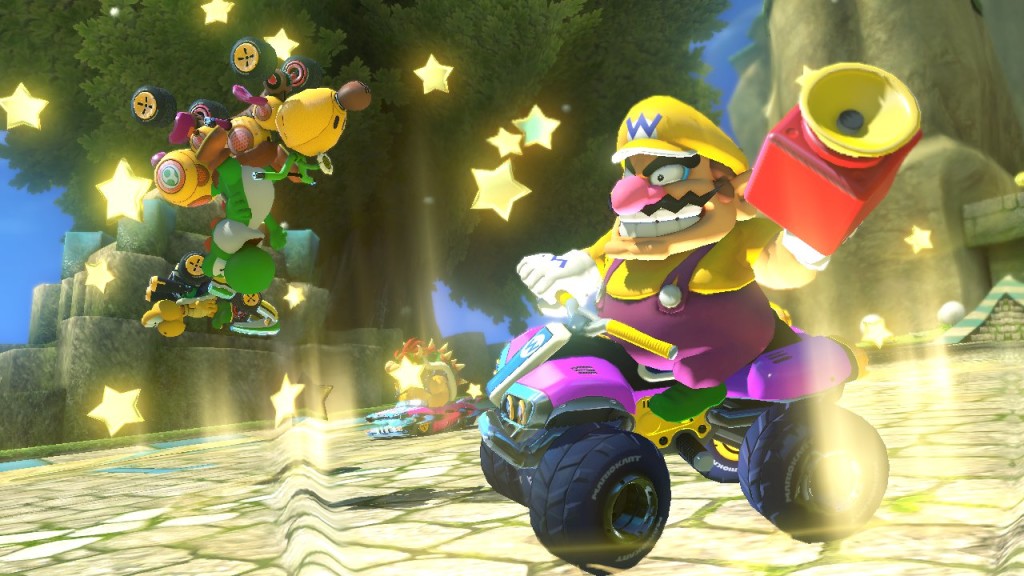Last updated on August 12, 2014
The last time I played a Mario Kart game with any degree of seriousness, the Playstation 2 reigned as the console of choice, and Nintendo found themselves in a position very similar to their current situation – a distant third, somehow, to the rest of the console market. Rather than rest on their laurels, Nintendo uses these down times to create some incredibly stellar products; Double Dash!! (I know everyone hates it and I still don’t know why) stole the spotlight then, and Mario Kart 8 stole the spotlight now (and apparently sold a whole lot too!)
Mario Kart’s last console venture felt wholly unsatisfying to me. For whatever reason, Nintendo removed the power slide system in its Wii incarnation…well, not so much removed as placed under a barrier of Automatic versus Manual steering, which made no sense in a kart racer then and makes no sense now. Mario Kart Wii holds all the right elements for being an excellent kart racer, but the level designs just aren’t that exciting. There’s really no interesting or neat gimmicks apart from the Wii steering wheel, and that doesn’t add much, if anything, to the package. In other words, it’s a cheap cash-in, all said, with a lack of overall improvements. As I haven’t played the portable entries as of late, I can’t give a comment on that, but most critical reception says they didn’t hold up that well.
What I can say, after hours and hours and hours of wrist-straining fun, is that Mario Kart 8 adds some pizzazz and some neat additions to a seemingly stale formula. Mario Kart 8 takes elements both old and new while re-configuring them all into new course designs that really take advantage of a renewed focus on power slides. I mean, seriously, you need to drift or power slide to get around nearly every corner, but it’s not a chore at all! Obviously, there’s a new and more predictable physics system at works, mostly determined by what character and car parts you pick beforehand.

Cars, motorcycles, and other crazy vehicles come in three parts now which edit your stats, regardless of which character you pick, and finding your ideal character/vehicle combo remains a treat of experimentation. Coins return from the earliest games in the series, allowing for a constant increase of speed even if you’re in the lead (this is great for the disgruntled person in first place who never obtains any interesting items). Furthermore, doing tricks in the air makes it worth your while to use it on every single jump, with the minor speed boost contributing a lot. Slipstreaming rewards player for driving behind opposing players for three seconds with an enormous speed boost.
Environmental obstacles add their own flavor. Flying sections also force you to control a gliding cart hurtling at high speed toward the ground; gliding longer gives you a great advantage as you hover right over obstacles. Underwater sections also provide unique obstacles, as your turns take more effort underwater and your top speed often ends up reduced. Certainly, Nintendo HAS done these things before (in Mario Kart 7, I believe), but the new anti-gravity mechanics take the cake. Allowing course design that move up, left, and sideways, anti-gravity sections of the course disorient you and operate on a really strange principle: most obstacles you hit will actually provide a speed boost. This allows for unorthodox strategies and optimum lines, especially in driving other players off the course or maintaining a boost line throughout a huge section.
As for weapons, Nintendo finally saw fit to balance the egalitarian Blue Spiny Shell via the Super Horn, which will actually destroy the Skill-Punisher if you happen to get it (pro-tip: if you plan on winning, try to keep one). Most of the other new abilities just seem added for flavor purposes: a boomerang does exactly what a boomerang does, while the pirahna plant hit any other person in your general vicinity (unless someone hits you and steals it!) while eating your coin bank. As for the regular standards (red and green shells, bananas, mushrooms), they work just like you’d expect, and sometimes you’ll get them all if you get the 8 item!

In a way, everything about Mario Kart 8 sounds bog standard for this genre, and completely played out. On paper, what else could you imagine? Where Mario Kart 8 makes its mark comes in the races themselves. None of the above would work if not for the 16 new course designs, which absolutely take advantage of this confluence of mechanical interplays. Simply put, they’re massive and tend to contain every single mechanic in some way, shape, or form. Some courses simple take you on one long downward journey, with laps being more like checkpoints than actual circuits (Mount Wario’s a personal favorite).
The central gimmicks of each one celebrate games within the Mario universe while presenting unique obstacles that force you to drive in different ways. You get your old standards (Bowser’s Castle is especially frightening, even if Rainbow Road underwhelms), your new ideas (Cloudtop Cruise’s finally uses airships! And Toad Harbor may as well be the Mario version of San Francisco), and I can’t think of a single course that I don’t remember. The retro course provide the same thrills due to a massive redesign that hits your nostalgic nerve while working within Mario Kart 8’s new constraints (they feel really short by comparison with the new stuff, though). All of them provide you with plenty of time to make your move and recover from any horrible crashes too. Sure, Mario Kart 8 often descends into chaos, but that’s the charm. Skill still reigns supreme for the most part, with the occasional coordinated assault by the AI or other horrible human beings on the couch and online.
And really, all of Mario Kart 8’s greatest feats come purely through polish and refinement. Or, really, those awesome physics which I cannot describe in text at all, yet make the game itself utterly transcendent in the moment. Nothing here will amaze you if you played any Mario Kart game of the past few decades, and yet I found myself enjoying this the most out of any Mario Kart game yet. Add online play, and I could see myself enjoying it for a long, long time. As you might know, I love drifting, and Mario Kart 8’s narrow tracks LOVE drifting, so more drifting in Mario Kart almost equals perfection from me. Yes, I will give a five star rating for polish.
Accusing Nintendo of iterative games and a lack of innovation is like accusing God for not changing His mind; it ain’t gonna happen:
8 Jesus Christ is the same yesterday and today and forever.
Hebrew 13
God doesn’t change, merely because to imply He would changed means He would, at one point, think differently of you than He does now. We think of this lack of “dynamism”, so to speak, as a limitation, but that would make Jesus Christ less of a solid rock and more a house of cards that could fall with the blow of the wind. Rather, God’s nature remains so all-encompassing that we could not perceive the difference between “staying the same” and “change”. A limit of perspective, in other words. I guess that’s why I am fine with Nintendo’s lack of change – they make the games they want to make, and often that’s all it takes to turn a good game series into a great one.
You gotta wonder why Nintendo made the game this way, appealing to the hardcore fan (like myself) but also snatching quite a big audience for the Wii U. If I had to take a guess, Nintendo saw Sega’s Sonic & All-Stars Racing Transformed, an incredibly solid and innovative kart racer, and thought they could top what they’d already done. Yes, you’ve got the transforming karts (here, we’ve got anti-gravity racers) and underwater sections, but none of these sections mess with the handling quite as much as they do in Sumo Digital’s product. On the other hand, Sonic’s racing games focus excessively on constant drifting and boosts to get ahead on linear courses (read: skill and possibly an unhealthy love for OutRun), whereas Mario Kart 8 sprinkles drifting and power sliding among stun jumps, shortcuts, and disorienting course designs. Honestly, your preference (and I have none, really) comes down to what kind of design you enjoy more, and that’s purely up to the player.
